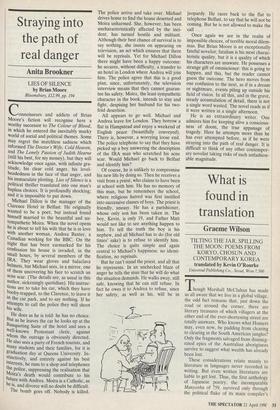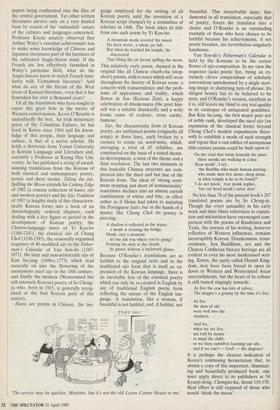What is found in translation
Graeme Wilson
TILTING THE JAR, SPILLING THE MOON: POEMS FROM KORYO, CHOSUN AND CONTEMPORARY KOREA translated by Kevin O'Rourke
Universal Publishing Co., Seoul, Won 7,500
Though Marshall McCluhan has made us all aware that we live in a global village, the odd fact remains that, just down the road or around the corner, there are literary treasures of which villagers at the other end of the ever-shortening street are totally unaware. Who knows what Homers may, even now, be padding from clearing to clearing in the South American jungles? Only the fragments salvaged from disinteg- rated epics of the Australian aboriginees survive to suggest what wealth has already been lost.
These considerations relate mainly to literature in languages never recorded in writing. But even written literatures are liable to get lost. Thus, the first anthology of Japanese poetry, the incomparable Manyoshu of 759, survived only through the political fluke of its main compiler's papers being confiscated into the files of the central government. Yet other written literatures survive only on a very limited basis by reason of the 'outlandish' nature of the cultures and languages concerned. Professor Keene astutely observed that Arthur Waley's essential achievement was to make some knowledge of Chinese and Japanese literatures part of the furniture of the cultivated Anglo-Saxon mind. If the French are less effectively furnished in Waley's particular field, what do the Anglo-Saxons know to match French fami- liarity with Vietnamese literature? And what do any of the literati of the West know of Korean literature, even that it has flourished for over a thousand years?
Of all the translators who have sought to repair this great hole in the weave of Western consciousness, Kevin O'Rourke is undoubtedly the best. An Irish missionary priest of the Columban Fathers, he has lived in Korea since 1964 and his know- ledge of that people, their language and culture, is that of a native scholar. He holds a doctorate from Yonsei University in Korean Language and Literature and, currently a Professor at Kyung Hee Uni- versity, he has published a string of award- winning translations from the Korean of both classical and contemporary poetry, novels and short stories. Tilting the Jar, Spilling the Moon extends his Cutting Edge of 1982 (a concise collection of hansi, sijo and modern poetry) and his Sijo Tradition of 1987 (a lengthy study of this characteris- tically Korean form) into a book of six chronologically ordered chapters, each dealing with a key figure or period in the development of Korean poetry: the Chinese-language hansi of Yi Kyu-bo (1168-1241), the classical sijo of Chong Chol (1536-1593), the seasonally organised sequence of 40 modified sijo in the Fisher- man's Calendar of Yun Son-do (1587- 1671), the later and non-aristocratic sijo of Kim Su-jang (1690-c.1773) which lead naturally on into the flowering of the anonymous sasol sijo in the 18th century, and finally the modern (Westernised but still intensely Korean) poetry of So Chong- ju who, born in 1915, is generally recog- nised as the best Korean poet of this century.
Hansi are poems in Chinese, the Ian- guage employed for the writing of all Korean poetry until the invention of a Korean script (hangul) by a committee of scholars in 1446. The book takes its title from one such poem by Yi Kyu-bo: A mountain monk coveted the moon:
He drew water, a whole jar full, But when he reached his temple, he discovered
That tilting the jar meant spilling the moon. This relatively early poem, rhymed in the original like all Chinese chueh-chu (stop- short) poems, strikes notes which will recur throughout the history of Korean verse: a concern with transcendence and the prob- lems of appearance and reality, which flower in Son (Korean Zen); a happy celebration of drunkenness (the poet him- self was a notable drunkard); and a wrily ironic sense of realistic, even earthy, humour.
Sijo, the characteristic form of Korean poetry, are unrhymed poems (originally all songs) in three lines, each broken by a caesura to create six word-units, which, averaging a total of 45 syllables, are constructed on the basis of a stated theme, its development, a twist of the theme and a final resolution. The last two elements in this basically Chinese structure are com- pressed into the third and last line of the Korean form. The ideal of 'strong senti- ment stopping just short of sentimentality' sometimes declines into an almost currish combination of whine and bite, in effect rather as if Heine had taken to imitating the Portuguese fado; but in the hands of a master like Chong Chol its poetry is piercing:
A shadow is reflected in the water: a monk is crossing the bridge.
Monk, stay a moment: let me ask you where you're going? Pointing his stick at the clouds he passes without a backward glance. Because O'Rourke's translations are so faithful to the original texts and to the traditional sijo form that is itself an ex- pression of the Korean language, there is an inevitable loss of the essential poetry which can only be re-created in English by use of traditional English poetic form reflecting the nature of the English lan- guage. A translation, like a woman, if beautiful is not faithful; and, if faithful, not
'The service may be quicker, Marjorie, but it's not the old Lyons Corner House to me.' beautiful. This irresolvable issue, fun- damental in all translation, especially that of poetry, forces the translator into' a choice and O'Rourke is an outstanding example of those who have chosen to be faithful because his achievements, if not poetic beauties, are nevertheless singularly handsome.
Yun Son-do's Fisherman's Calendar is held by the Koreans to be the veriest flower of sijo-composition. In my view the sequence lacks poetic fire, being an ex- tremely clever compendium of scholarly conventions unredeemed by a single start- ling image or shattering turn of phrase4ts Alleged beauty has to be believed to -be seen; and O'Rourke's version, excellent as it is, still leaves me blind to any real quality in its catalogue of antiquated gentilities. But Kim Su-jang, the first major poet not of noble rank, developed the sasol sijo (an expansion of the classical form) beyond Chong Chol's modest experiments there- with to establish a mode of such strength and vigour that a vast edifice of anonymous 18th-century poems could be built upon it: On the road that twists beneath the pines three monks are walking in a line.
'Rear monk', I cry, 'the Buddha who made human parting, who made men live alone, sleep alone, in what temple is he to be found?'
'I do not know,' rear monk replies, 'but our head monk's sister does'.
No less than 78 of the present book's 267 translated poems are by So Chong-ju. Though the overt sensuality in his early work and their blunt references to copula- tion and micturition have encouraged com- parison with the poems of Baudelaire and Yeats, the essence of his writing, however reflective of Western influences, remains incorruptibly Korean. Drunkenness, trans- cendence, Son Buddhism, sex and the Chinese Confucian literary heritage are all evident in even his most modernised writ- ing. Korea, the justly called Hermit King- dom, may have been forced to open its doors to Western and Westernised Asian encroachments, but the heart of its culture is still turned singingly inwards:
At five the cow has lots of calves; The magpie's a granny by the time it's five.
At five the men of old were well into the Analects.
And we, when we are five, are told by mama to mind the child or we busy ourselves learning our abc,
and if we can't — God! — the disgrace! It is perhaps the clearest indication of Korea's continuing hermeticism that, to obtain a copy of this important, illuminat- ing and beautifully produced book, one must apply direct to its publishers at 54 Kyunji-dong, Chongno-ku, Seoul 110-170. Real effort is still required of those who would 'drink the moon'.



















































 Previous page
Previous page